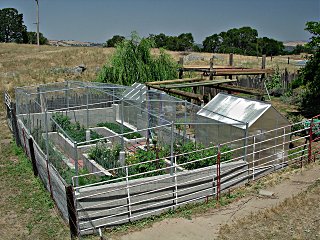 Here is an overview of our new vegetable garden. It has two small greenhouses (see next picture) and a 16' x 32' walled and screened garden with a sunken walkway.
Here is an overview of our new vegetable garden. It has two small greenhouses (see next picture) and a 16' x 32' walled and screened garden with a sunken walkway. Here is an overview of our new vegetable garden. It has two small greenhouses (see next picture) and a 16' x 32' walled and screened garden with a sunken walkway.
Here is an overview of our new vegetable garden. It has two small greenhouses (see next picture) and a 16' x 32' walled and screened garden with a sunken walkway.
The concrete block walled garden is planted with potatoes, lettuce, elephant garlic, green onions, red onions, strawberries, artichokes, dill, asparagus, tomatoes, bell peppers, cucumbers, zucchini, blueberries, raspberries, blackberries, arugula, basil, and cilantro. A few more will be added later.
The canopy of 1" mesh chicken wire is to keep out birds, ground squirrels, and sphinx moths (that produce tomato worms). The sunken path takes away quite a bit of planting area, but makes weeding and harvesting much easier on the body. A drainage system takes water from the pathways out to a nearby field. The concrete blocks go 3 feet down under the ground, quite close to an underlying granite layer and should keep out ground squirrels and gophers. The above ground part of the wall is to keep out rattlesnakes and to help provide a thermally protected environment. The winter sun comes in from the side away from the greenhouses.
The materials cost, including the greenhouses and their footings, some potting soil, peat, and plants was about $3400, labor was free - just a whole bunch of healthy exercise.
Our llamas provide great manure for the garden. They deposit their "llama beans" into convenient piles which we use as needed after the piles age for a few months. Their digestive system is so efficient that very few viable weed seeds make it through into their manure. Furthermore, the "beans" act a bit like time-release capsules.
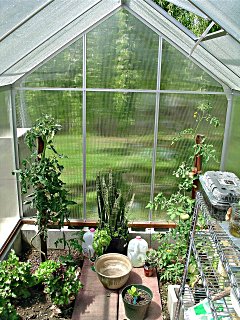 This is a picture of the inside of one of the little greenhouses. They are 6 feet wide by 8 feet long and about 7 feet tall at the middle. They only cost $300 (on sale) from Harbor Freight Tools. The manufacturing quality was excellent although the instructions were a bit of a challenge. For the price, they can't be beat.
This is a picture of the inside of one of the little greenhouses. They are 6 feet wide by 8 feet long and about 7 feet tall at the middle. They only cost $300 (on sale) from Harbor Freight Tools. The manufacturing quality was excellent although the instructions were a bit of a challenge. For the price, they can't be beat.
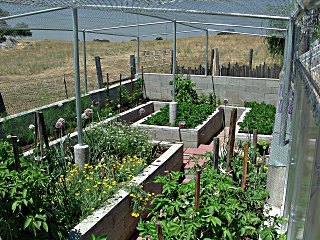 This shows the vegetable garden plants about 11 weeks after planting when viewed from the northeast corner.
This shows the vegetable garden plants about 11 weeks after planting when viewed from the northeast corner.
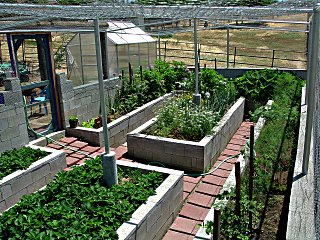 This shows the vegetable garden plants about 11 weeks after planting when viewed from the southwest corner.
This shows the vegetable garden plants about 11 weeks after planting when viewed from the southwest corner.
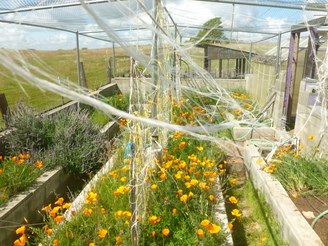 On March 29, shortly after social isolation started for the COVID-19 pandemic, we realized that we should resurrect our neglected vegetable garden. It is shown here overgrown with wild poppies which thrive because the garden is gopher-proof. As beautiful as they are, they needed to be replaced with lettuce, tomatos, onions, bell peppers, cucumbers, zucchini, and more.
On March 29, shortly after social isolation started for the COVID-19 pandemic, we realized that we should resurrect our neglected vegetable garden. It is shown here overgrown with wild poppies which thrive because the garden is gopher-proof. As beautiful as they are, they needed to be replaced with lettuce, tomatos, onions, bell peppers, cucumbers, zucchini, and more.
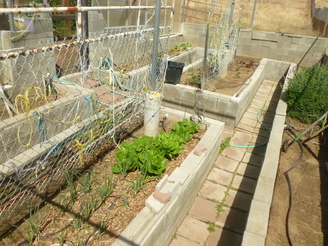 May 20, 2020: Not everything is obvious in this picture, but after 7 weeks of effort, it is starting to look pretty good.
May 20, 2020: Not everything is obvious in this picture, but after 7 weeks of effort, it is starting to look pretty good.
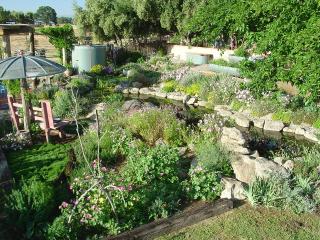 Here is a view of our pond garden looking toward the northeast from up on a ladder. Started it in the fall of 2003, it is continuing to be gradually embellished.
Here is a view of our pond garden looking toward the northeast from up on a ladder. Started it in the fall of 2003, it is continuing to be gradually embellished.
There is a 3000-gallon pond surrounded by granite boulders. The pond has goldfish, mosquito fish, frogs and garter snakes hiding amongst the parrot's feather, water hyacinths, duckweed, and water iris. The water, circulated by a solar-powered pump, flows in from the top-middle of this picture spilling from the end of a water trough barely visible under the surounding plants. Evaporated water is replenished from a old, abandoned well into which we placed a solar-powered pump that also supplies various animal water troughs.
We refer to this as our "heavy metal" garden, because it has become the last resting place for retired ranch metal objects. An old, leaky water tank was moved in and made into a garden shed with a curved door and a cement floor. The two raised planters at the upper-right started life as a single, large water-pressure tank, but became a pair of water troughs long ago when they failed to hold pressure. Finally, when they became too leaky, we made them into planters where they serve as our plant convalescent hospital and nursery.
Various pieces of old machinery and welded metal sculptures also decorate the garden. An old satellite dish placed upside-down on a power pole section serves as a shade for one of the resting spots, and is a trellis for a Jenny Moser clematis as well as a Moonflower, a fragrant night-blooming variety of morning glory. A new 250-gallon oval water trough up against the wall on the right serves as a soaking tub in the summer.
Portions of our two large wisteria trellises can be seen to the left of the garden shed. They were made from retired power pole sections and cover a patio area extending out of the picture on the left.
There are olive trees in the center background and a mullberry tree on the right.
In the foreground at the left is an area covered with mounding marjoran, a great replacement for lawn grass. We use it between stones in the patio area where it is self-spreading and crowds out weeds. In the center foreground is also a small area with plants particularly enjoyed by butterflys, birds, bees, a variety of bugs. Toads, lizards and garter snakes especially enjoy this area.
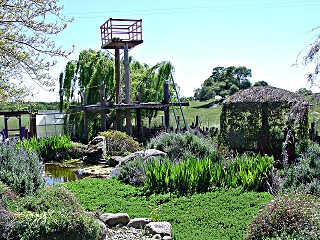 The lower part of this platform was built a few years ago for no good reason except that it seemed like a nice idea. It still has no railing or stairway, but in 2011 I added an upper platform that could look over the chicken yard's willow tree and watch wildlife over a large part of the ranch. It also provides nice views of the pond garden from above.
The lower part of this platform was built a few years ago for no good reason except that it seemed like a nice idea. It still has no railing or stairway, but in 2011 I added an upper platform that could look over the chicken yard's willow tree and watch wildlife over a large part of the ranch. It also provides nice views of the pond garden from above.
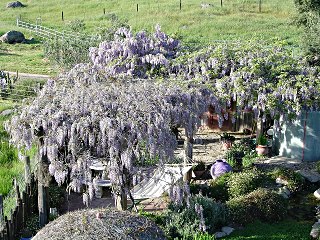 This is a view of our wisterias in full bloom in April, 2011. Often, rain or wind causes the blooms to be less spectacular, but this year was perfect. The leaves are just appearing and soon will shade the hammock and garden table through the summer.
This is a view of our wisterias in full bloom in April, 2011. Often, rain or wind causes the blooms to be less spectacular, but this year was perfect. The leaves are just appearing and soon will shade the hammock and garden table through the summer.
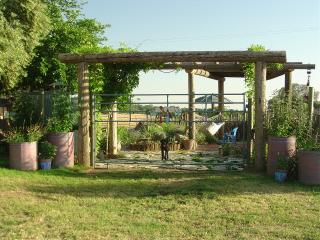 The original entrance to the garden from our driveway is shown here with Black Labrador Bailey posing in the center. The 4 large cylindrical planters were made from two retired water pressure tanks. On the gate is a metal picture entitled "Apache Crossing" and hanging from the near trellis at its left side (hidden by the wisteria in this picture) is a stained glass image of an Indian Girl. Pictures of these are shown below.
The original entrance to the garden from our driveway is shown here with Black Labrador Bailey posing in the center. The 4 large cylindrical planters were made from two retired water pressure tanks. On the gate is a metal picture entitled "Apache Crossing" and hanging from the near trellis at its left side (hidden by the wisteria in this picture) is a stained glass image of an Indian Girl. Pictures of these are shown below.
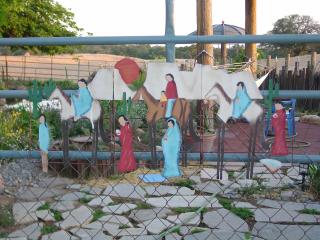 "Apache Crossing" art decorating the entrance gate.
"Apache Crossing" art decorating the entrance gate.
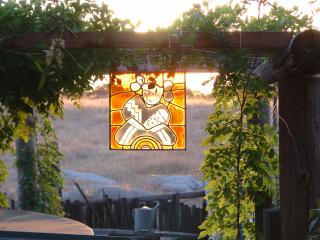 Stained glass image of a Hopi Girl.
Stained glass image of a Hopi Girl.
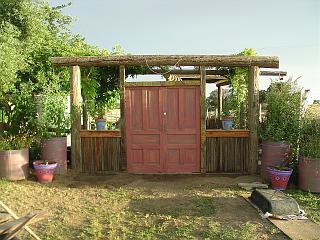 Here is our new garden entrance. The doors were gifts from a neighbor's remodeling and are at least 100-years old. We will find more suitable planters to put on the shelves on either side of the doors and expect to put a little roof above the doors.
Here is our new garden entrance. The doors were gifts from a neighbor's remodeling and are at least 100-years old. We will find more suitable planters to put on the shelves on either side of the doors and expect to put a little roof above the doors.
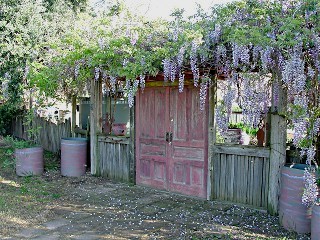 By 2011, after 6 years of wisteria growth, our garden entrance looks like this in the Spring.
By 2011, after 6 years of wisteria growth, our garden entrance looks like this in the Spring.
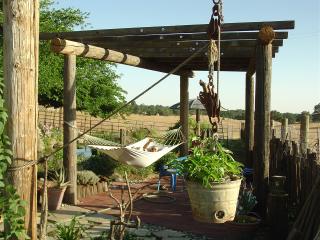 Looking south from the northwest corner shows the hammock trellis and its red cement block floor. In the foreground is an old calf feeding pail that has lost its nipple and become a planter for a busy lizzie. The pail hangs from the entrance trellis. The gardener, Marren (dubbed "Queen of Green" by coworkers at the greenhouse where she works), studies garden magazines in the hammock.
Looking south from the northwest corner shows the hammock trellis and its red cement block floor. In the foreground is an old calf feeding pail that has lost its nipple and become a planter for a busy lizzie. The pail hangs from the entrance trellis. The gardener, Marren (dubbed "Queen of Green" by coworkers at the greenhouse where she works), studies garden magazines in the hammock.
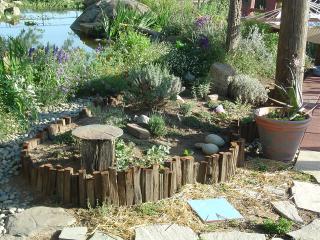 Between the hammock trellis and the pond is a small mound garden bordered by posts made from retired redwood vineyard grape stakes. The original mound garden here was luxuriant, but had been discovered by a gopher. We rebuilt it with wire mesh about 8 inches down and added the bordering stakes.
Between the hammock trellis and the pond is a small mound garden bordered by posts made from retired redwood vineyard grape stakes. The original mound garden here was luxuriant, but had been discovered by a gopher. We rebuilt it with wire mesh about 8 inches down and added the bordering stakes.
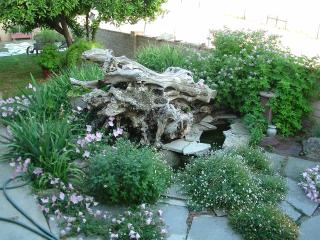 This is our patio garden on the South side. Three old Oak stumps were stacked out in a field some distance from the house, but begged to be placed in our patio garden. Each weighed about 300 pounds and were transported (with considerable effort) to the garden and stacked using a come-along and a 12'-high tripod. Water is pumped up from a pair of buried water troughs and flows down from near the high pointback into the troughs. A solar-panel powers the pump.
This is our patio garden on the South side. Three old Oak stumps were stacked out in a field some distance from the house, but begged to be placed in our patio garden. Each weighed about 300 pounds and were transported (with considerable effort) to the garden and stacked using a come-along and a 12'-high tripod. Water is pumped up from a pair of buried water troughs and flows down from near the high pointback into the troughs. A solar-panel powers the pump.
Mexican Evening Primrose and Santa Barbara Daisys dominate the foreground.
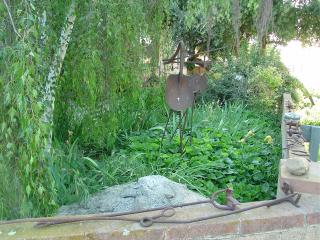 On the North side, near our front entrance is a Weeping Birch. At its feet are beds of violets, iris, and daffodils. There is also a tiny pond used by one of our toads. The metal sculptures are of herons.
On the North side, near our front entrance is a Weeping Birch. At its feet are beds of violets, iris, and daffodils. There is also a tiny pond used by one of our toads. The metal sculptures are of herons.
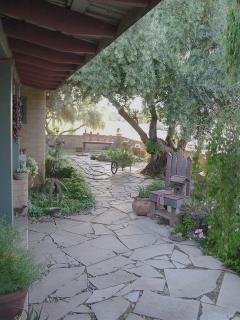 Next to the front door is this courtyard under an Olive tree on the North side of the house.
Next to the front door is this courtyard under an Olive tree on the North side of the house.
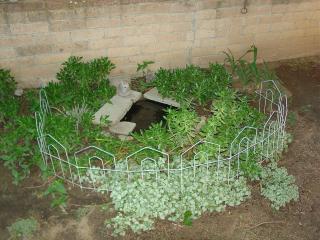 At the southwest corner of our house is a buried 2' diameter wash tub that is the home to a solitary goldfish. It is surrounded by Spider Lilys, a mystery succulant, Lamium, Day Lilys, Busy Lizzie, and Snow-in-Summer.
At the southwest corner of our house is a buried 2' diameter wash tub that is the home to a solitary goldfish. It is surrounded by Spider Lilys, a mystery succulant, Lamium, Day Lilys, Busy Lizzie, and Snow-in-Summer.
This area is under a large Mulberry tree whose shallow roots suck the ground dry in the summer and prevent heavy roto-tilling.
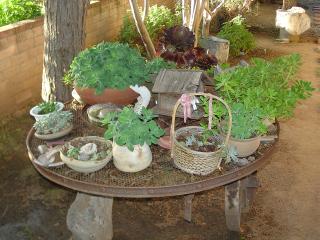 This is one of several "cart" gardens. The cart is a metal sculpture made from discarded ranch parts. Going clockwise, starting with the wicker basket, the plants here are
This is one of several "cart" gardens. The cart is a metal sculpture made from discarded ranch parts. Going clockwise, starting with the wicker basket, the plants here are
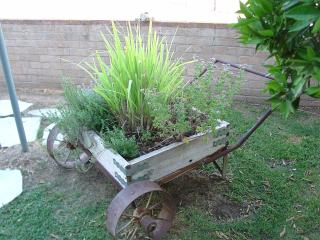 This hand-made cart, which used to cart around an air conditioner between shops on a ranch, now is an herb garden. It is placed under the Orange tree in the summer, and moved out into the sun in the winter.
This hand-made cart, which used to cart around an air conditioner between shops on a ranch, now is an herb garden. It is placed under the Orange tree in the summer, and moved out into the sun in the winter.
Last updated: May 22, 2020
Contact Craig Van Degrift if you have problems or questions with this web site.